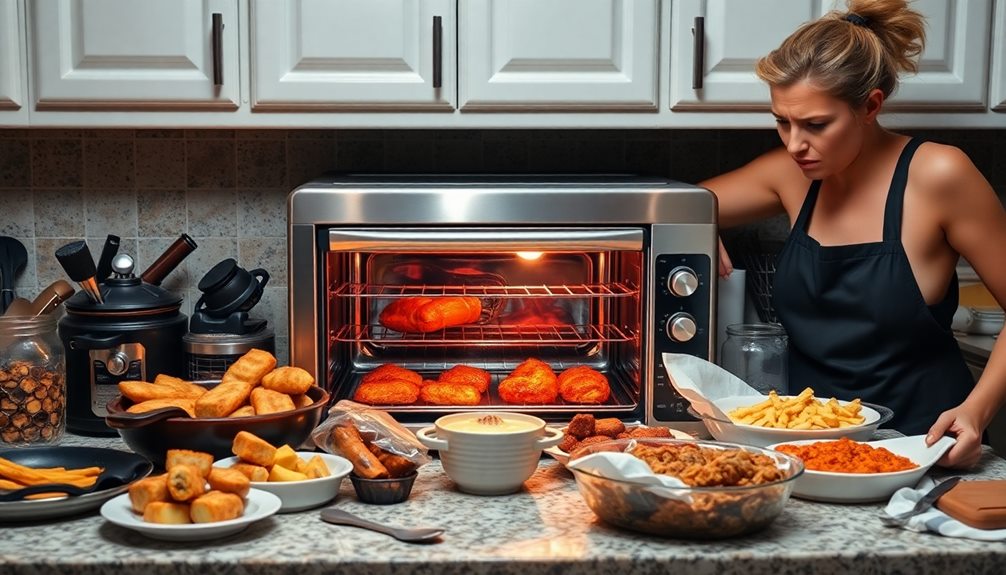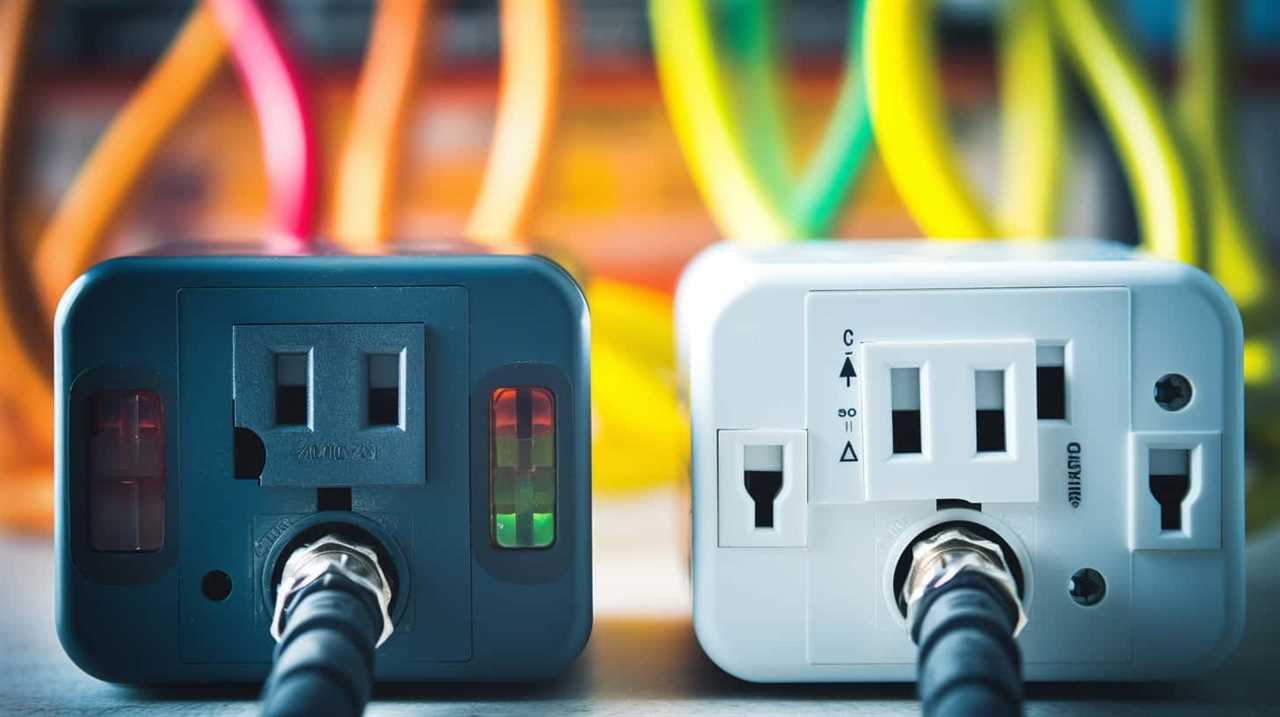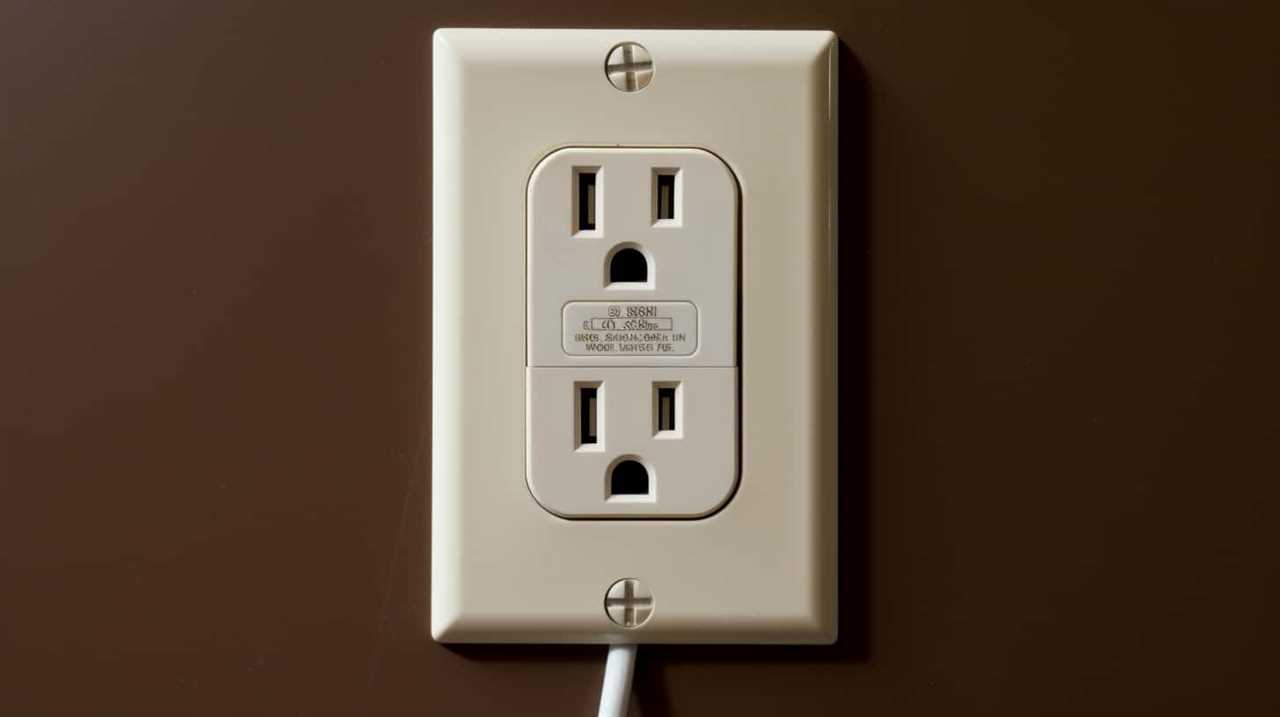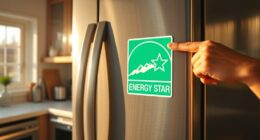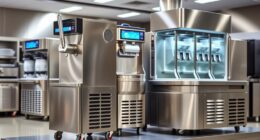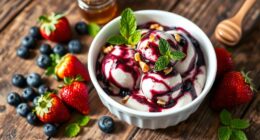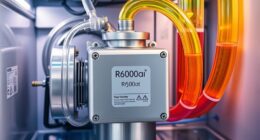Before buying a convection oven, consider its drawbacks. They tend to have a higher initial cost, and you'll need to adjust cooking times and temperatures, which can involve a learning curve. Not every recipe works well; delicate items might dry out or not rise properly. Additionally, airflow issues with deep pans can lead to uneven cooking. Noise from the fan can also be distracting, and they might consume more energy than traditional models. Overall, understanding these disadvantages will help you make an informed choice and guarantee you're fully prepared. There's more to uncover, so keep exploring!
Key Takeaways
- Convection ovens have a higher initial cost, typically ranging from $100 to $500 more than conventional models.
- Cooking adjustments are necessary, including lowering temperatures by 25°F and reducing cooking times by 25%.
- Not suitable for delicate recipes like soufflés and custards, which may suffer from uneven heat and airflow issues.
- Maintenance can be more complex due to fans and motors, leading to higher repair needs and costs.
- Operation noise from fans can disrupt meal prep, with sound levels comparable to normal conversation.
Higher Initial Cost
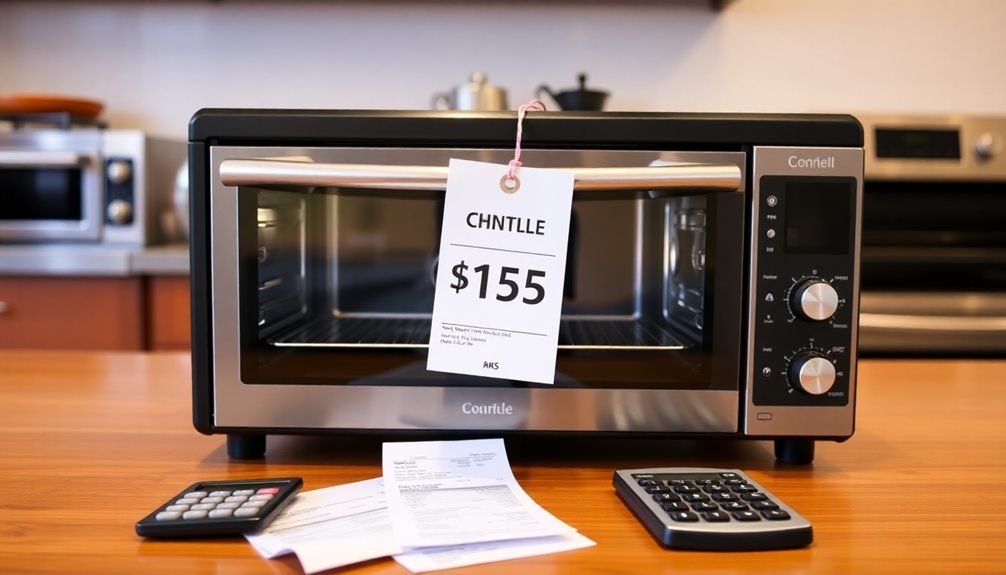
Although convection ovens offer numerous advantages, one significant drawback is their higher initial cost. Typically, these ovens range from $100 to $500 more than conventional models, depending on features and brand. This higher initial cost stems from advanced technology, including built-in fans and additional heating elements, which enhance cooking efficiency but also add to the price tag.
For home cooks considering a convection oven, it's essential to weigh this significant investment against your budget constraints. While some high-end convection oven models can exceed $2,000, many users find that the energy savings over time can mitigate those initial costs. The efficiency of convection cooking often leads to lower utility bills, making it a more economical choice in the long run.
When evaluating the higher initial cost, don't overlook the long-term usage benefits. If you plan to use your convection oven frequently, the advantages may outweigh the upfront expense.
Ultimately, if you're committed to enhancing your cooking experience, investing in a convection oven could prove worthwhile despite the initial financial commitment.
Learning Curve for Adjustments
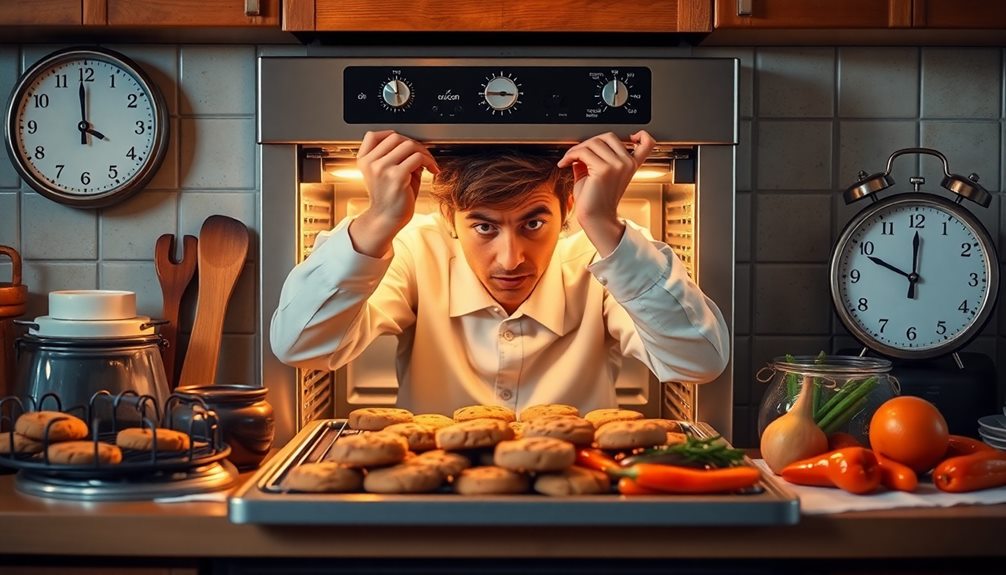
Steering through the learning curve for adjustments when using a convection oven can feel challenging at first.
You'll quickly discover that recipes designed for conventional ovens often require changes in cooking times and temperatures. Typically, you'll need to reduce the temperature by about 25°F and shorten cooking time by roughly 25%.
The fan circulates hot air, which can lead to overcooking, especially with delicate dishes like soufflés or cakes. It's vital to monitor your food closely during the cooking process.
You may also find that experimenting with different rack placements and pan types is necessary for ideal airflow and cooking results. Shallow pans are generally recommended for better circulation.
This trial and error approach is part of the learning curve, as some dishes may need specific adjustments to avoid drying out due to the constant air movement.
Familiarizing yourself with your convection oven's settings and features is essential, as modern models often include various modes that can greatly impact cooking results depending on what you're preparing.
Embrace the process, and soon you'll be cooking like a pro!
Risk of Over-Drying

Using a convection oven can enhance your cooking experience, but it also comes with the risk of over-drying your food. The continuous circulation of hot air can lead to moisture loss, particularly in delicate items like fish or baked goods that rely on moisture retention. Foods with high water content, such as vegetables, may rapidly lose their moisture due to constant airflow, affecting their texture and flavor.
To help you better understand the impact of using a convection oven, here's a quick overview:
| Factor | Impact on Cooking |
|---|---|
| Delicate Items | Higher risk of over-drying |
| High Water Content | Loses moisture quickly |
| Cooking Times | Requires closer monitoring |
| Mitigation Strategies | Lower temperature settings & marinades |
To mitigate the risk of over-drying, consider using lower temperature settings and covering dishes with foil. Additionally, adjusting your recipes by incorporating moisture-rich ingredients or marinades can help counteract the drying effects. By taking these steps, you can enjoy the benefits of convection cooking while preserving the quality of your dishes.
Noise From Fan Operation
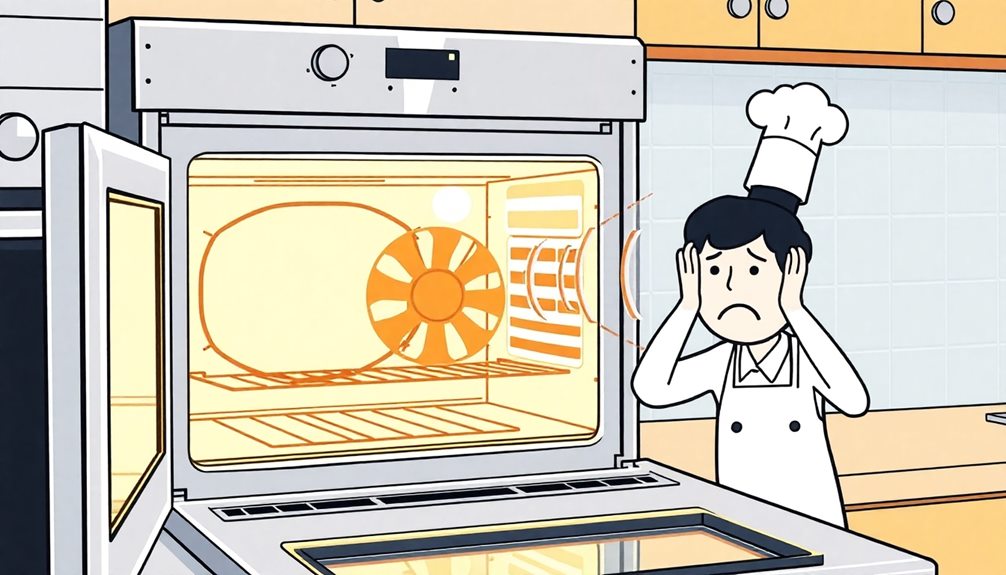
When you use a convection oven, you might notice that the fan can create a noticeable noise that affects your cooking environment.
This noise can be particularly distracting if you're preparing delicate dishes that require longer cooking times.
Fortunately, some models come with noise-reduction features or quieter fan designs, allowing you to enjoy a more peaceful cooking experience.
Impact on Cooking Environment
Although convection ovens are popular for their even cooking, the noise from their fan operation can be a significant downside. For those who cherish quieter kitchen environments, this can be particularly disruptive. The noise levels typically range from 40 to 60 decibels, comparable to a normal conversation. This might be bothersome, especially if you're sensitive to sound.
Here are some aspects to evaluate:
- Disruption during meal prep: Constant noise can hinder your cooking flow.
- Increased maintenance: Over time, the fan's motor may suffer wear and tear, leading to louder operation and potential replacement needs.
- Cooking at high temperatures: The fan noise often amplifies when you're cooking multiple dishes simultaneously.
- Less pleasant cooking experience: A noisy oven can detract from the joy of cooking, turning a creative process into a frustrating task.
If you're pondering a convection oven, be sure to check sound ratings. While some models boast quieter fan designs, it's crucial to find one that won't interfere with your culinary adventures.
Mitigating Noise Levels
To reduce noise levels in your convection oven, consider a few simple strategies that can enhance your cooking experience. The noise from the fan operation can disrupt your peaceful kitchen environment, especially if you're sensitive to disturbances. To help you choose a quieter model, check user reviews for noise complaints, as the fan noise varies considerably between models.
| Feature | Benefits | Recommended Models |
|---|---|---|
| Noise Reduction Technology | Quieter operation during cooking | Brand X Model A |
| Adjustable Fan Settings | Control fan use for different cooking methods | Brand Y Model B |
| Regular Maintenance | Reduces noise and extends lifespan | Brand Z Model C |
| Design Improvements | Enhanced quiet features | Brand W Model D |
Regular maintenance, such as cleaning the fan and ensuring it's balanced, can also help minimize noise. If noise remains a concern, look for convection ovens with specific features designed for quieter operation or those that let you turn off the fan for certain cooking methods. By being mindful of these factors, you can enjoy a more pleasant cooking experience.
Quiet Oven Alternatives
Finding a peaceful cooking environment can be challenging with the operational noise of convection ovens, primarily caused by the fan. For those who cherish quiet kitchens, the constant fan noise can be disruptive, especially during lengthy cooking sessions.
If you're sensitive to noise, here are some quiet oven alternatives to evaluate:
- Conventional Ovens: They operate silently without the fan, ensuring a serene cooking experience.
- Low-Noise Mode Models: Some convection ovens come with a low-noise mode, allowing you to enjoy convection cooking with minimal disruption.
- Silent Mode Options: Brands offer convection ovens equipped with a silent mode, virtually eliminating fan noise while cooking.
- Noise-Reducing Features: Look for convection ovens that advertise noise-reducing features to help minimize that background hum.
When you're in search of the perfect oven, remember to check product specifications. Not all convection ovens are created equal; some can produce noticeable operational noise.
Balancing your culinary needs with your desire for tranquility can lead to a more enjoyable cooking experience.
Not Ideal for All Recipes
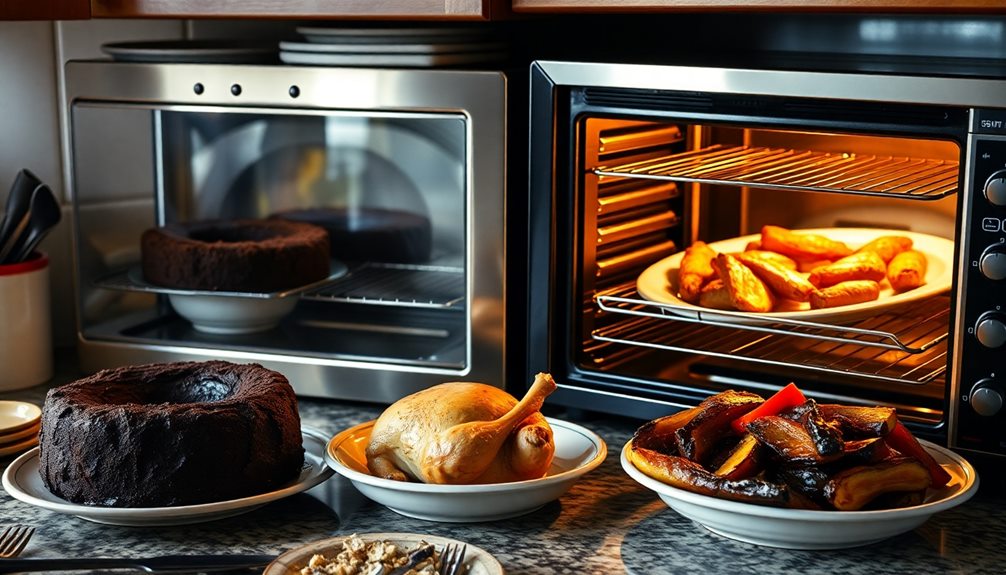
Convection ovens can be a game-changer for many cooking tasks, but they aren't ideal for every recipe.
If you love baking, you might find that delicate baked goods like cakes and soufflés don't rise as well in convection ovens. The constant airflow can create denser textures that aren't what you want.
Recipes that rely on precise baking conditions, such as bread that needs steam, may also suffer, as the fan can dry out the surface too quickly.
Traditional desserts, like custards, mightn't set properly because of the uneven heat distribution caused by the fan.
Delicate pastries, especially meringues, can crack and develop undesirable textures due to the moving air.
You'll often need to adjust cooking times and temperatures, as recipes meant for conventional ovens might yield poor results in a convection setting without modification.
Before you commit to a convection oven, consider the types of recipes you enjoy.
If you often bake pastries or delicate desserts, you may want to stick with conventional ovens for those specific creations.
Maintenance and Repair Needs
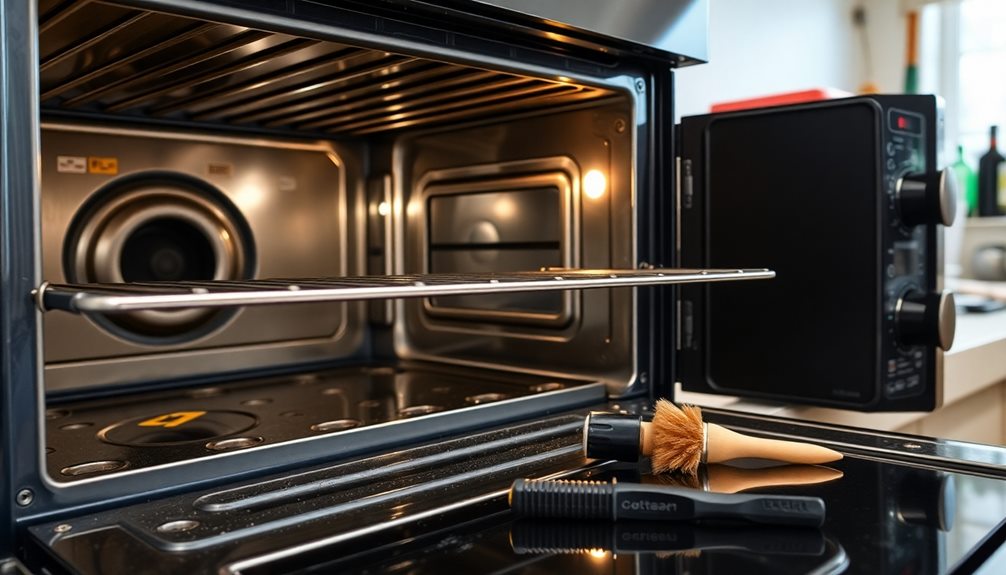
Maintaining a convection oven can be more involved than with a conventional oven due to its complex components, like fans and additional motors.
These complexities can lead to higher repair needs, making it vital for users to stay ahead of maintenance tasks.
Here are some maintenance and repair challenges you may face:
- Operational Noise: The fan can produce disruptive noise, prompting you to reflect on sound dampening solutions or quieter models.
- Cleaning Requirements: Regular cleaning is important to prevent buildup in the fan and filters, which can hinder performance and reduce longevity.
- Replacement Parts: If you need to replace parts like fans or heating elements, be prepared for potentially higher costs and difficulty in sourcing them.
- Model-Specific Needs: Each convection oven model has unique maintenance requirements, so familiarize yourself with yours to guarantee peak performance and extend its lifespan.
Airflow Issues With Pans

When using a convection oven, airflow plays a key role in achieving even cooking results. If you opt for deep or high-sided pans, you might run into airflow issues that obstruct airflow. This can lead to uneven cooking and unsatisfactory browning of your food.
To guarantee ideal air circulation, it's best to use shallow flat pans, which allow hot air to circulate freely around your dishes.
Another common mistake is overcrowding the oven with too many pans. When you fill the oven to the brim, you disrupt airflow, causing some dishes to cook slower or unevenly. Maintaining adequate spacing between your dishes is essential; you should typically allow at least 1-2 inches of space around each pan.
Additionally, avoid using foil or other coverings, as they can block airflow and reduce the efficiency of convection cooking.
Limited Baking Versatility
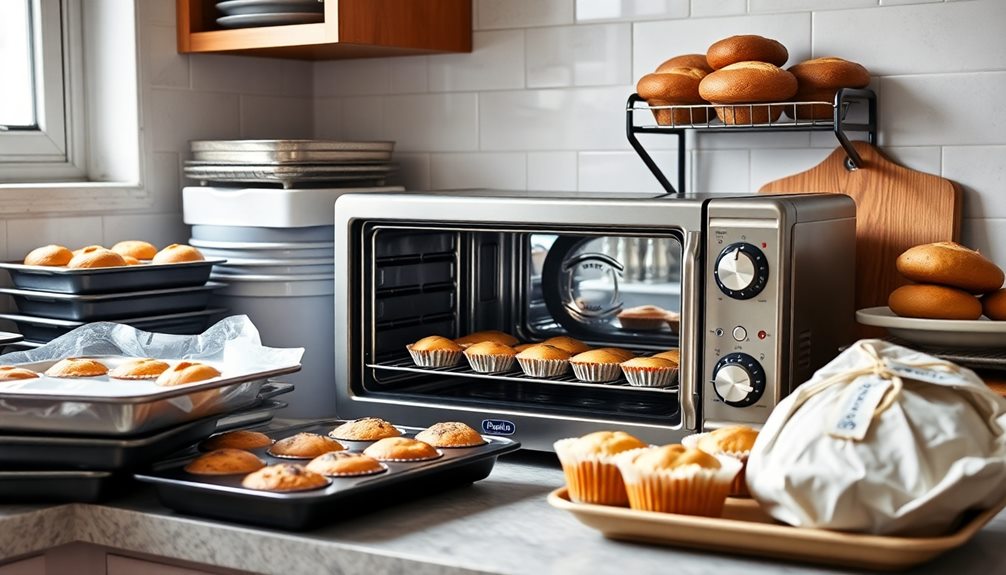
For those who love baking, switching to a convection oven can pose challenges due to its limited versatility in handling certain recipes. The convection process, which involves constant air movement, mightn't be the best friend of your favorite baked goods.
Here are some specific concerns you should keep in mind:
- Delicate items like cakes and soufflés can suffer from disrupted rise and texture, leading to inconsistent results.
- Recipes for breads and pastries often require significant adjustments in cooking times and temperatures, complicating your baking routine.
- The airflow can over-dry muffins or quick breads, making it tough to achieve that perfect moisture and softness.
- For custards and flans, the stable heat source of a conventional oven typically yields better results due to minimal air movement.
Additionally, using shallow pans to maximize airflow limits your options for bakeware, potentially affecting your overall baking performance.
If you're passionate about achieving consistent results with all your baked goods, consider these limitations before making the switch to a convection oven. Your cherished recipes deserve the right environment to shine!
Cooking Time Adjustments Required
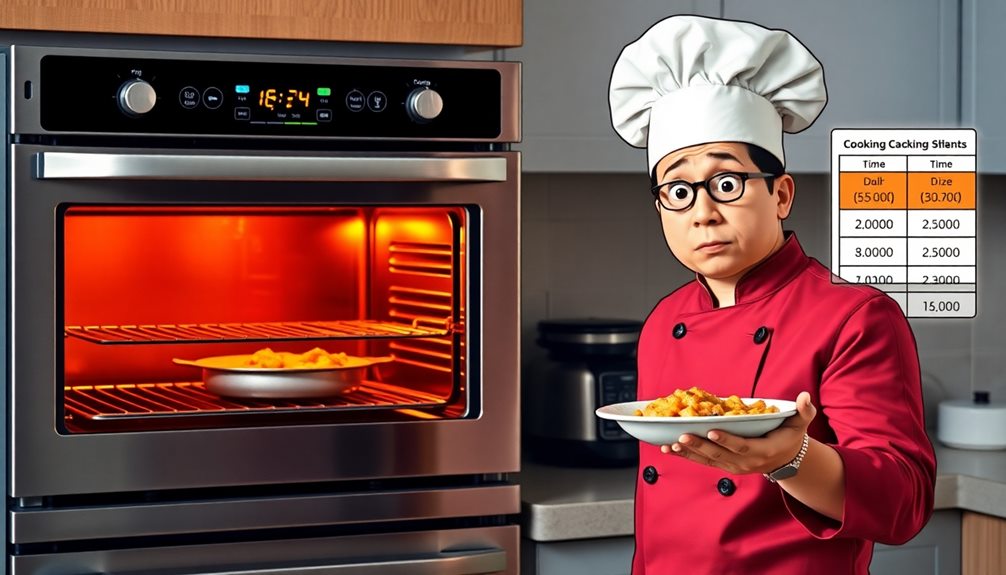
Baking in a convection oven can introduce a new layer of complexity, particularly concerning cooking times. Unlike conventional ovens, convection cooking typically requires you to lower the temperature by about 25°F. Furthermore, you'll likely find that cooking times are reduced by approximately 25%, meaning you'll need to monitor food closely to avoid overcooking or undercooking.
Static recipes that don't consider these adjustments can easily lead to disappointment, especially with baked goods like cakes and breads. It might take you several tries to nail the right balance of time and temperature due to the faster cooking environment. Checking for doneness a few minutes earlier than usual is a smart practice when adapting to convection cooking.
Here's a handy reference table for your cooking adjustments:
| Food Type | Cooking Time Adjustment |
|---|---|
| Baked Goods | Reduce by 25% |
| Roasted Vegetables | Reduce by 25% |
| Meats | Check for doneness earlier |
| Casseroles | Reduce time, monitor closely |
| Cookies | Reduce time, keep a close eye |
Potential Energy Consumption Increase
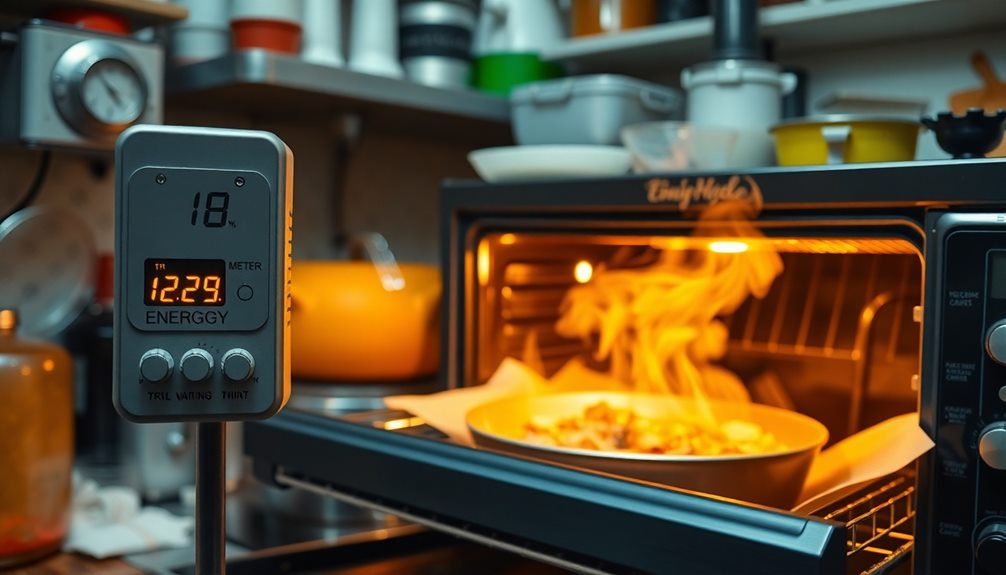
Energy consumption can be a significant concern when using a convection oven. While these ovens are known for their faster cooking times, they often come with a potential energy consumption increase that could surprise you.
Here are some factors to take into account:
- 20% more energy: Convection ovens typically consume about 20% more energy than traditional ovens due to the fan motor and additional heating elements.
- Higher electricity usage: Frequent use can lead to increased electricity usage, which can really add up on your energy bills.
- Preheating power: The higher energy consumption during preheating means these ovens often require more power to quickly reach desired temperatures.
- Model comparison: Energy efficiency ratings vary widely, so it's important to compare models to find one that meets your cooking needs without breaking the bank.
While convection ovens may offer advantages, their higher energy consumption can offset the benefits of faster cooking.
Make sure you take these factors carefully into account to avoid unexpected costs. Balancing your cooking needs with energy efficiency will help you make the best choice for your kitchen.
Frequently Asked Questions
Is There a Downside to a Convection Oven?
Yes, there are downsides to convection ovens. You might find that they require temperature adjustments, can over-dry foods, and produce noise, making them less ideal for delicate baking or quiet cooking environments.
When Should You Not Use a Convection Oven?
You shouldn't use a convection oven for baking delicate items like soufflés, custards, or covered stews. Those recipes benefit from gentle, even heat, which a conventional oven provides better than a convection oven can.
What Should I Look for in a Convection Oven?
When you're shopping for a convection oven, consider its size, cooking modes, temperature control, cleaning ease, and noise level. You want something versatile and user-friendly, making your culinary adventures as smooth as butter!
Is a Convection Oven Good for Health?
Yes, a convection oven's even heat distribution cooks food faster and retains nutrients better. You can enjoy healthier meals with less fat, reduced harmful compounds, and the ability to prepare multiple dishes without flavor transfer.
Conclusion
Before diving headfirst into buying a convection oven, you might want to pause and consider its quirks. Sure, it promises crispy fries and speedy meals, but it can turn your cookies into sad, crunchy frisbees if you're not careful. Plus, the noise? It'll sound like a jet engine in your kitchen! Don't forget the learning curve; you'll feel like a mad scientist trying to perfect your recipes. Weigh the pros and cons—your culinary sanity might depend on it!
